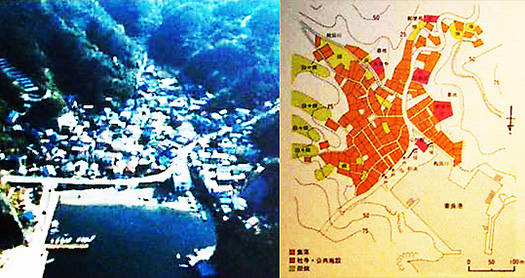住宅を取材するほどより大きな環境要件「街割り」に注目することが多い。
現代の家づくりとは「個人主義」の最先端的な実現領域であることから
間取りだとか、利便性デザイン性などに目が集中するけれど、
「住みごこち」には、もうちょっと外縁的な部分の割合が大きいと思う。
それは町、街区自体の魅力のようなもの。
しかし現代生活はある画一化が前提になっていると思う。
それはクルマ社会への基本対応。公共道路アクセスの実現が基本的条件。
公共が提供するインフラ要素、交通とエネルギーは道路がすべて担っている。
現代生活ではこうした側面を支える公共の役割があって暮らしが成立する。
公共道路の基本要件はクルマ尺度での移動可能性の保証。
住宅敷地はその1面が「接道」されていないと基本欠格とされる。
結果として「街割り」の没個性化、非自然的画一化のもとではないか。
そして建てられる住宅はほぼ「生業」からはかけ離れた生存が目的。
こういう家の建てられようはどうも少し異様なのではないかと思える。
たぶんこうした住宅群では、地域社会というものが希薄化する。
身近な他者との共生という概念よりも、個人主義が優先している。
それは上辺は住みやすいようでいて、高齢化社会を考えれば不都合が多い。
他者との関係性が希薄で気楽だけれど、地域共生のマユが消えていく。
それに対して、伝統的「街割り」都市形成はあくまでも徒歩でのアクセス。
エネルギーについては、定住最初期の縄文以来、
薪を採取可能な地域範囲によっての人口上限が制約だったのだと思う。
図と写真でみている伊豆半島の妻良地区の事例。
まずは交通について考えると、最大の生業としての海産漁のための舟運。
そして集落を貫く陸路がありクルマ以前の交通条件は満たされている。
バイオマスエネルギー薪の確保も後背山地から豊富に確保できる。
街割りとしては個別の敷地は不定形だけれど、ほぼ用を満たしている。
現代生活ではこのエネルギー確保問題は電気ガス石油ともほぼ解決した。
各戸間は公共道路としての現代の最低要件幅を満たしていないけれど、
人口減を見据えて一定間隔で既存住宅敷地がクルマ駐車場に転換されれば、
現代生活でも十分に活用可能なのだろうと思われます。
むしろムダに広いクルマ道路を全戸に用意する市街地域の拡大維持は
今後の人口減少社会を考えれば、地域の自滅的要素であることは確実。
市街地面積の無秩序な拡大はインフラ維持の高コスト化を強いる。
むしろ例のような街割りの方がサスティナブルな要素が高いのではないか。
コロナ禍で現代住宅の基本立地要件が変化する可能性がある。
これまでの企業立地環境要件がそのままではなくなる可能性がある。
テレワークの進展で企業・就業のスタイルが大きく変容しつつあり
この方向自体は不可逆的な変化ではないかと推定できる。
逆に言えば、テレワークに最適化した企業にこそ発展の可能性が高い。
どうもそのように社会ルールの基底が変化してきているように思えてならない。
そうであるとすれば、今後の住宅立地選択はどのように変容していくか、
非常に興味深いのではないかと、変化の芽をウォッチしています。
Click here for the English version. ⬇
[Human residence after the corona wreck? Izu village “town division” case]
Corona sickness may change the basic location requirements for modern homes. Optimization for telework. Basis change of social rules.・ ・ ・
We often pay attention to the larger environmental requirement “city allocation” as we cover houses.
Because modern home building is a cutting-edge realization area of ”individualism”
I concentrate on the floor plan and convenience design, but
I think that the proportion of the outer part is a little larger in “living comfort”.
It’s like the charm of the town or block itself.
However, I think that modern life is premised on a certain standardization.
That is the basic response to the automobile society. Realization of public road access is a basic condition.
Roads are responsible for all the infrastructure elements, transportation and energy provided by the public.
In modern life, there is a public role to support these aspects and life is established.
The basic requirement for public roads is the guarantee of mobility on a car scale.
A residential site is basically disqualified if one side of it is not “closed”.
As a result, it may be the source of the personalization and unnatural standardization of “town division”.
And the purpose of the house to be built is to survive far from “living business”.
I think it’s a little strange to build such a house.
Perhaps these housing groups dilute the community.
Individualism takes precedence over the concept of coexistence with others close to us.
It seems that the upper side is easy to live in, and there are many inconveniences considering the aging society.
The relationship with others is weak and easy, but the cocoon that coexists with the community disappears.
On the other hand, the traditional “city division” city formation is only accessible on foot.
Regarding energy, since the earliest settlement of Jomon,
I think that the upper limit of the population was restricted by the area where firewood can be collected.
An example of the Mera district on the Izu Peninsula as seen in the figures and photos.
First of all, considering transportation, boat transportation for marine fishing is the biggest livelihood.
And there is a land route that runs through the village, and the traffic conditions before the car are satisfied.
Biomass energy firewood can also be secured abundantly from the back mountains.
Although the individual sites are irregular as a town division, they are almost satisfied.
In modern life, this energy security problem has almost been solved with electric gas and oil.
Although each house does not meet the modern minimum requirements for public roads,
If the existing residential site is converted to a car parking lot at regular intervals in anticipation of population decline,
It seems that it can be fully utilized in modern life.
Rather, the expansion and maintenance of the urban area, which provides all the units with wide car roads to waste,
Considering the future population decline society, it is certain that it is a self-destructive factor in the region.
The disorderly expansion of the urban area forces the cost of maintaining infrastructure to increase.
Rather, the city division as in the example may have a higher sustainable element.
The corona epidemic may change the basic location requirements for modern homes.
There is a possibility that the existing corporate location environmental requirements will not remain the same.
With the progress of telework, corporate and employment styles are undergoing major changes.
It can be inferred that this direction itself is an irreversible change.
Conversely, companies that are optimized for telework have a high potential for development.
It must seem that the basis of social rules is changing like that.
If so, how will future housing location choices change?
I’m watching the buds of change, which may be very interesting.
Posted on 1月 13th, 2021 by 三木 奎吾
Filed under: 「都市の快適」研究, 住宅マーケティング









コメントを投稿
「※誹謗中傷や、悪意のある書き込み、営利目的などのコメントを防ぐために、投稿された全てのコメントは一時的に保留されますのでご了承ください。」
You must be logged in to post a comment.